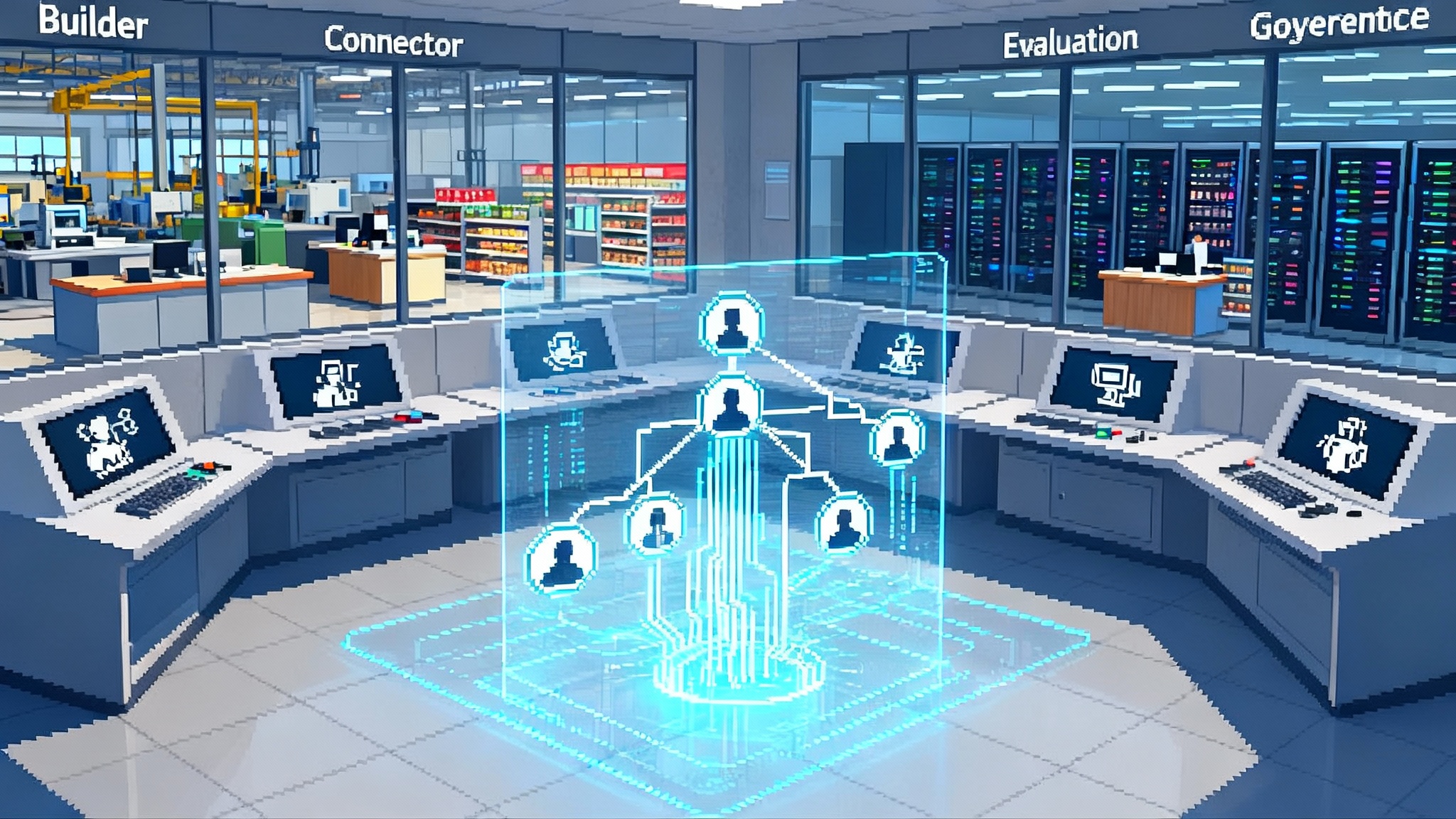Edge First AI: When Device Architecture Becomes Ethics
Assistants are splitting across device and attestable cloud. This edge-first shift rewrites memory, identity, and consent, turning privacy into an execution path. Here is the playbook for builders, buyers, and IT teams.

Breaking shape: assistants that live in two places at once
The line between your device and the cloud has moved. Apple is ramping Private Cloud Compute, a server fleet that runs large models on Apple silicon with verifiable privacy guarantees. Apple describes the system as an extension of on-device security into the data center, complete with code signing, a Secure Enclave, and remote attestation so your iPhone or Mac can verify the server image before sending any part of your request. That shift is documented in Apple’s own write-up of Private Cloud Compute, which is worth reading for its security model and promise of independent inspection by researchers. See Apple’s description of Private Cloud Compute for specifics on attestation and stateless processing in the Private Cloud Compute technical overview.
Reports over the past year have also suggested that the next version of Siri will delegate certain reasoning, planning, or summarization tasks to a custom Google Gemini model running inside Apple’s Private Cloud Compute environment. The point is not that Gemini would replace Siri’s identity. The pattern is a chorus: a local model for personal context, a remote but attestable model for heavy lifting, and an orchestration layer that fuses the two without leaking your life.
Microsoft has been redrawing the line as well. After criticism of Recall, which indexed on-screen content to help you find anything you had seen on a Copilot+ PC, the company reworked the experience with opt-in, hardware-backed encryption, and virtualization-based isolation. The most important change is not a toggle. It is the recognition that an assistant’s memory is a security boundary, not a convenience feature. Microsoft describes the new model in a detailed engineering post, captured in the Update on Recall security and privacy architecture.
Meanwhile, the 2025 hardware cycle has delivered neural processing units that can finally hold their own. Laptops and tablets routinely ship with more than 40 NPU tera-operations per second, with total platform throughput well above 100 when you add the graphics engine. That is enough to keep a sophisticated small or medium model resident, to run speech and vision continuously, and to perform private retrieval on your documents without a trip to a data center. The point is not benchmark one-upmanship. The point is that modern assistants are becoming edge-first by design, with the cloud acting as an extension rather than a destination.
Architecture is becoming ethics
When an assistant spans your device and an ephemeral, attestable cloud, the architecture answers questions that used to be philosophical.
-
What is memory? On device, memory might be a vector store, a screenshot index, or a folder of notes. In an attestable cloud like Private Cloud Compute, memory is not a persistent corpus. It is a temporary slice of your request, shipped only when required, executed against a model image your device attests, then wiped. In practical terms, memory becomes a policy about what is allowed to persist and where. If the policy states that the cloud is stateless, then long-term memories must live locally or be encrypted under keys the cloud never holds.
-
What is identity? Your assistant is a composition of identities. The voice you know as Siri or Copilot is a persona. The local model on your laptop is another identity, signed by the operating system vendor. The remote model is yet another identity, attested by cryptographic proof that a particular server image is running. Identity becomes supply chain, and your device is the verifier. As firms reorganize around agent runtimes, this feels a lot like what we described when the firm turns into a runtime.
-
What is consent? If a feature like Recall is opt-in and gated by Windows Hello, that is consent expressed through biometrics and secure hardware. If a cloud call requires your device to verify a pristine image before sending data, that is consent expressed through remote attestation. In both cases, consent is not a check box in a settings menu. It is a runtime protocol. This pairs naturally with a consent layer for licensed training, where usage terms are enforced by systems rather than promises.
This is why architecture is becoming ethics. The answer to who sees your data is not a paragraph in a privacy policy. It is an execution path constrained by keys, attestation, and compute boundaries.
The edge-first case: agency, privacy, resilience
Edge-first design is not just a performance trick. It changes who holds the steering wheel.
-
Agency. When the primary model and retrieval live on the device, you can shape the assistant. You can mount your own knowledge base, inject tools, and test changes without asking a cloud provider for permission. Picture a photographer with a custom voice workflow that understands the Lightroom catalog structure. With a strong NPU and a local retriever, that workflow is your workflow, not a web service.
-
Privacy. Private Cloud Compute is designed so that Apple cannot see your requests, and Microsoft’s Recall now binds decryption keys to your Windows Hello presence inside a virtualization-based enclave. The practical outcome is that day-to-day interactions can remain on hardware you own, while heavy lifting happens on servers that prove what code they run and forget what they saw.
-
Resilience. Edge-first assistants degrade gracefully. If the network drops, you still get transcription, translation, and task management. If a provider has an outage, your local model does not. If a policy changes tomorrow, your cached tools still function.
Edge-first does introduce engineering complexity. It requires synchronization between a local model and a remote planner, secure key management, and a way to audit what traveled off device. But the payoff is agency now, with privacy and resilience that are properties of the architecture, not promises in a press release.
New failure modes to watch for
Moving intelligence to the edge and adding an attestable cloud does not remove risk. It moves it and creates new failure modes. Three merit special attention.
-
Leaky personal context. If your assistant maintains a local memory or screenshot index, any tool that can read it becomes a covert exfiltration path. A seemingly benign plug-in that asks for file system or camera access can infer sensitive facts.
Mitigation: Treat the assistant’s local memory like a password manager vault. Gate access through a dedicated broker that enforces least privilege and presents synthetic views of data to untrusted tools. On Windows, keep Recall’s index inside a virtualization-based security enclave with strict inter-process contracts. On macOS and iOS, require entitlements and data class protections for anything that touches the assistant’s store.
-
Shadow memory. When the cloud is stateless by design, developers will be tempted to rebuild persistence in other places: crash logs, telemetry caches, or third-party service calls. The danger is a memory that the product team never named and that compliance never reviewed.
Mitigation: Ship a transparency log for every remote request. The device should be able to export a compact, human-readable record of what data moved, which attested image processed it, and where the response came from. Apple already provides activity reports for Private Cloud Compute requests on some platforms. That idea should become a baseline across the industry. It aligns with the case for AI signature layer receipts, where verifiable records become part of the product.
-
Policy drift. A model that plans tasks across local and remote tools can drift away from the user’s stated policy. For example, it might decide that sending a larger excerpt to the cloud yields better quality, ignoring a user’s preference to keep context local.
Mitigation: Train the planner with explicit cost and privacy budgets, and make those budgets first-class controls. If a request would exceed a budget, the assistant should pause and ask for permission with a clear explanation, not a generic dialog.
The new markets this unlocks
Architectural shifts create products and categories. Edge-first assistants with attestable cloud backends will pull several markets forward.
-
Personal inference budgets. Think of a wallet that covers compute instead of currency. You set a monthly limit for cloud inference minutes and a separate limit for local fine-tunes and retrieval updates. The assistant allocates across local and remote according to your preferences. Vendors will offer bundles: a phone plan that includes a Private Cloud Compute allotment, a laptop plan that adds local fine-tuning credits, a family plan that meters shared models across devices. Billing becomes a knob you can turn to trade latency and quality for cost and privacy.
-
Confidential application programming interfaces. An API that requires attestation proofs from a Private Cloud Compute image, or a Windows enclave, before it will accept a request. Your calendar app can expose a confidential endpoint that only a verified assistant process can call, and only with a user presence signal. This is not hand-wavy. The building blocks exist today in Apple’s attestation design and in Windows virtualization-based enclaves. A marketplace of confidential endpoints is the next obvious step.
-
Local fine-tunes as a product. With stronger neural processing units, vendors can sell small supervised fine-tunes that never leave your machine. A sales team could buy a local adapter that teaches assistants how to draft proposals in the company’s voice, complete with product facts and regulatory phrases, without prompts or outputs crossing an external boundary. Suppliers might ship updates as tiny parameter deltas, the way keyboard models ship new languages.
-
Trusted toolchains. Developers will sell audited tool sets that are guaranteed to run only inside attested environments. A medical dictation tool could advertise that it executes only in a Private Cloud Compute image that matches a specific transparency log entry, or inside a Windows Copilot+ enclave with a certain firmware measurement. The product is not only the model. It is the guarantee about where that model runs.
What builders should do now
If you build assistants, or tools for assistants, the near-term actions are concrete and testable.
-
Define a memory contract. Write down what persists, where, and for how long. Include screenshot indices, retrieval stores, and derived embeddings. Ship a user-visible memory dashboard that can erase, export, or move each class of data.
-
Require attestation for remote calls. If your assistant hits a cloud model, verify the server image hash before sending any data. Cache the hash with a timestamp and show it in your activity report. If attestation fails, handle it visibly. The user should know that the assistant downgraded to a smaller local model.
-
Budget privacy and cost. Add a slider that lets users set a monthly cloud inference budget and a maximum context size per request. Train your planner to respect these limits, and expose a dry run that shows the tradeoffs for a given task before it runs.
-
Isolate tools. Run third-party tools in constrained environments with capability-based access to the assistant’s memory. For desktop, prefer containers with strict inter-process communication contracts. For mobile, prefer system entitlements and brokered access through operating system services.
-
Ship an audit export. Provide a signed, human-readable log that lists which requests left the device, which attested image processed them, and what toolchain executed locally. Users, administrators, and regulators will ask for this. You will earn trust faster by offering it first.
-
Practice incident drills. Treat privacy failures like outages. Run tabletop exercises that assume a tool exfiltrates context, a planner exceeds a privacy budget, or attestation fails. Define rollback procedures and user notices in advance.
What buyers and IT teams should ask vendors
The procurement checklist should not be about model size. It should be about guarantees.
-
Can the product prove where it runs? Ask for a description of the attestation flow and the hash policy for remote images. Request sample logs.
-
Where does memory live and how is it erased? Ask for exact retention periods, key custody, and whether the cloud component is stateless by construction.
-
What happens when the network is unavailable? Ask for a clear fallback path that keeps key tasks available on device. Test it in a dead network room before purchase.
-
How do I cap spend and exposure? Ask for controls to budget cloud inference and to restrict maximum context sizes or categories of data permitted to leave the device.
-
How are third-party tools contained? Ask for isolation architecture, permissions brokerage, and a way to disable any tool that tries to cross the line.
-
What receipts do I get? Ask for verifiable execution records that match a transparency log, aligning with the case for AI signature layer receipts.
The 2025 device cycle is the catalyst
The hardware has arrived. Laptops with more than 40 NPU tera-operations per second are no longer demos. Phones now balance local models with remote inference that is attested and stateless. Microsoft is re-architecting assistant memory around user presence and hardware keys. Apple is building an attestable cloud that behaves like an extension of your device rather than a data sink. The net effect is a new baseline: personal intelligence that belongs to the person who paid for the device, not to the server that answered a request.
If there is a philosophical stance here, it is that the fastest way to get better assistants is to move more of them home. Edge-first design turns privacy into a property of execution. It gives users agency because they can see and shape the parts that matter. It makes the whole system more resilient because most of it keeps working when the network does not. The cloud still matters. It just answers to the device.
Bottom line
The next year will be a contest of architectures as much as features. Products that treat memory as a vault, identity as a verifiable supply chain, and consent as a protocol will feel different. They will be trusted by default. And in a market crowded with assistants that all talk, trust will be the voice that carries.








